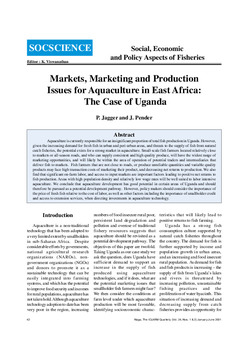Markets, marketing and production issues for aquaculture in East Africa: the case of Uganda

Citation
Jagger, P.; Pender, J. (2001). Markets, marketing and production issues for aquaculture in East Africa: the case of Uganda. NAGA 24 (1/2): 42-51
Aquaculture is currently responsible for an insignificant proportion of total fish production in Uganda. However, given the increasing demand for fresh fish in urban and peri-urban araes, and threats to the supply of fish from natural catch fisheries, the potential exists for a strong market in aquaculture. Small-scale fish farmers located relatively close to markets or all-season roads, and who can supply consistent and high quality produce, will have the widest range of marketing opportunities, and will likely be within the area of operation of potential traders and intermediaries that deliver fish to markets. Fish farmers that are not close to roads, or produce unreliable quantities and variable quality products may face high transaction costs of marketing their product, and decreasing net returns to production. The authors found that significant on-farm labor, and access to input markets are important factors leading to positive net returns to fish production. Areas with high population density and relatively low wages will be well suited to labor intensive aquaculture. The authors concluded that aquaculture development has good potential in certain areas of Uganda and should therefore be pursued as a potential development pathway. However, policy makers should consider the importance of the price of fresh fish relative to the cost of labor, as well as other factors including the importance of smallholder credit and access to extension services, when directing investments in aquaculture technology.
Permalink
Date Available
Type
Publisher
Countries
Copyright
CC BY 4.0
Research Themes
Language